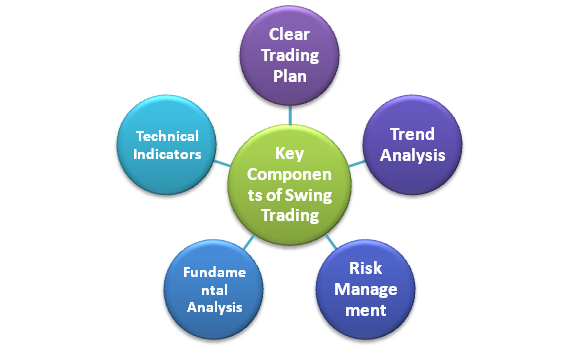Are you seeking a trading approach that offers the excitement of short-term trading with the potential for substantial profits? Look no further than the swing trading strategy!
This article will serve as a guide on swing trading enabling you to successfully execute this trading strategy. It describes the key components of a successful swing trading strategy, popular swing trading strategies, best indicators for swing trading, and the psychology of swing trading.
Contents
What is Swing Trading?
Swing trading is a trading style that involves holding positions for several days to weeks, capturing price swings within a broader market trend. Unlike day trading, swing traders don’t need to make quick decisions, allowing for a more relaxed approach to trading.
- Advantages of Swing Trading Strategy
- Opportunity to capture substantial price movements for higher profits.
- Less time-consuming than day trading, suitable for part-time traders.
- Reduced stress compared to day trading due to longer holding periods.
- Flexibility of screen time.
- Diversification
Key Components of a Successful Swing Trading Strategy

1. A Clear Trading Plan
Before entering any trade, a swing trader must have a clear and well-defined trading plan. This plan should outline;
- The entry and exit points
- Position sizing
- Risk management strategies
- Criteria for identifying potential trading opportunities
2. Trend Analysis
Trend analysis is a pivotal element for successful swing trading. It involves using technical analysis tools like trend line, moving average, support & resistance to determine whether the market is in an uptrend, downtrend, or ranging phase.
3. Technical Indicators
Technical indicators play a crucial role in swing trading strategies. They help you to identify entry and exit points, and gauge market momentum.
4. Fundamental Analysis
While swing trading relies heavily on technical analysis, incorporating fundamental analysis can provide valuable insights into the underlying factors influencing price movements. Traders must be aware of major economic events, earnings reports, and geopolitical developments that could impact their trades.
5. Risk Management
Managing risk is paramount in swing trading. Traders should never risk more than a predetermined percentage of their trading capital on any single trade. This ensures that a series of losing trades does not wipe out a trader’s account. Three essential principles of risk management in swing trading are;
- Using Stop Loss Order
- Proper Position Sizing
- Diversification
Popular Approaches for Swing Trading Strategy
- Moving Average Crossover Trading
The moving average crossover strategy involves using two different moving averages (e.g., 50-day and 200-day) to identify trend reversals and potential entry points.
- Breakout Trading
Breakout trading involves entering a trade when the price breaks above or below a significant support or resistance level, indicating a potential strong move.
- Pullback Trading
Pullback trading focuses on buying or selling during temporary price retracements within a larger trend, aiming to catch the next wave of the trend.
- Fibonacci Retracement Based Trading
Fibonacci retracement levels are used to identify potential support and resistance areas, helping traders plan their entries and exits.
Best Indicators for Swing Trading:
Swing Trading vs. Day Trading:
Swing trading involves holding positions for several days to weeks to capitalize on short to medium-term price movements. The traders use technical analysis, chart patterns, and market trends to identify potential entry and exit points.
Day trading involves opening and closing positions within the same trading day, with no positions held overnight. Day traders use technical analysis, level 2 quotes, and real-time data to make quick trading decisions.
Pitfalls of Swing Trading Strategy:
- Emotional decision-making rather than rational.
- Over trading
Emotions and Psychology in Swing Trading:
Swing traders must learn to manage emotions like fear and greed to avoid making impulsive decisions. When a swing trade becomes profitable, the market may lure beginners to book gains earlier than the specified target. Conversely, during a losing swing trade, the false hope of recovery may hamper a trader from booking a loss.
The only way to deal with emotions in swing trading is through developing a robust trade plan and maintaining discipline in executing the trading plan.
Is swing trading suitable for beginners?
Swing trading can be challenging for beginners due to its reliance on technical analysis and market timing. Beginners should gain experience through simulated trading before risking real capital.
End Note
Swing trading is a rewarding trading style that can offer substantial profits with a less hectic trading schedule. By understanding the key components of swing trading strategy and adopting a disciplined approach, you can increase your chances of success in the dynamic world of trading.

Pingback: 9 Best Stocks for Swing Trading in 2024
Pingback: Swing Trading Indicators Having Highest Success Rate